Defoe Daniel
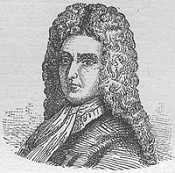
Daniel Defoe (c.1659 – 24 April 1731[1]), born Daniel Foe, was an English writer, journalist, and pamphleteer, who gained enduring fame for his novel Robinson Crusoe. Defoe is notable for being one of the earliest proponents of the novel, as he helped to popularise the form in Britain, and is even referred to by some as one of the founders of the English novel.[2] A prolific and versatile writer, he wrote more than five hundred books, pamphlets, and journals on various topics (including politics, crime, religion, marriage, psychology and the supernatural). He was also a pioneer of economic journalism. Daniel Foe (his original name) was probably born in the parish of St. Giles Cripplegate London. (Daniel later added the aristocratic sounding "De" to his name and on occasion claimed descent from the family of De Beau Faux.) Both the date and the place of his birth are uncertain with sources often giving dates of 1659 to 1661. His father, James Foe, though a member of the Butchers' Company, was a tallow chandler. In Daniel's early life he experienced first-hand some of the most unusual occurrences in English history: in 1665, 70,000 were killed by the plague. On top of all these catastrophes, the Great Fire of London (1666) hit Defoe's neighbourhood hard, leaving only his and two other homes standing in the area.[3] In 1667, when Defoe was probably about seven years old, a Dutch fleet sailed up the River Thames and attacked London. All of this happened before Defoe was around seven years old, and by the age of about thirteen, Defoe's mother had died.[4] His parents were Presbyterian dissenters; he was educated in a Dissenting Academy at Newington Green run by Charles Morton (later vice-president of Harvard University), and is believed to have attended the church there.[5] Although Defoe was a Christian himself, he decided not to become a dissenting minister, and entered the world of business as a general merchant, dealing at different times in hosiery, general woollen goods, and wine. Though his ambitions were great and he bought both a country estate and a ship (as well as civet cats to make perfume), he was rarely free of debt. In 1684, Defoe married a woman by the name of Mary Tuffley, receiving a dowry of £3,700. With his recurring debts, their marriage was most likely a difficult one. They had eight children, six of whom survived. In 1685, he joined the ill-fated Monmouth Rebellion, but gained a pardon by which he escaped the Bloody Assizes of Judge George Jeffreys. In 1692, Defoe was arrested for payments of £700 (and his civets were seized), though his total debts may have amounted to £17,000. His laments were loud, and he always defended unfortunate debtors, but there is evidence that his financial dealings were not always honest. Following his release, he probably traveled in Europe and Scotland, and it may have been at this time that he traded in wine to Cadiz, Porto, and Lisbon. By 1695 he was back in England, using the name "Defoe", and serving as a "commissioner of the glass duty", responsible for collecting the tax on bottles. In 1696, he was operating a tile and brick factory in what is now Tilbury, Essex and living in the parish of Chadwell St Mary. Defoe's first notable publication was An Essay upon Projects, a series of proposals for social and economic improvement, published in 1697. From 1697 to 1698, he defended the right of King William III to a standing army during disarmament after the Treaty of Ryswick (1697) had ended the Nine Years' War (1688–97). His most successful poem, The True-Born Englishman (1697), defended the king against the perceived xenophobia of his enemies, satirising the English claim to racial purity. In 1701, Defoe, flanked by a guard of sixteen gentlemen of quality, presented the Legion's Memorial to the Speaker of the House of Commons, later his employer, Robert Harley. It demanded the release of the Kentish petitioners, who had asked Parliament to support the king in an imminent war against France. Defoe's pamphleteering and political activities resulted in his arrest and placement in a pillory on July 31, 1703, principally on account of a pamphlet entitled The Shortest-Way with the Dissenters; Or, Proposals for the Establishment of the Church, purporting to argue for their extermination. In it he ruthlessly satirised both the High church Tories and those Dissenters who hypocritically practiced so-called "occasional conformity", such as his Stoke Newington neighbour Sir Thomas Abney. However, according to legend, the publication of his poem Hymn to the Pillory caused his audience at the pillory to throw flowers instead of the customary harmful and noxious objects, and to drink to his health. The historicity of this story, however, is questioned by most scholars, although the scholar J. R. Moore later said that “no man in England but Defoe ever stood in the pillory and later rose to eminence among his fellow men.”[4] Thomas Cochrane, the 10th Earl of Dundonald and famous Royal Navy officer, was sentenced to the pillory, but was excused for fear his popularity would cause a riot. After his three days in the pillory, Defoe went into Newgate Prison. Robert Harley, 1st Earl of Oxford and Mortimer, brokered his release in exchange for Defoe's co-operation as an intelligence agent. Within a week of his release from prison, Defoe witnessed the Great Storm of 1703, which raged from 26 to 27 November, the only true hurricane ever to have made it over the Atlantic Ocean to the British Isles at full strength. It caused severe damage to London and Bristol and uprooted millions of trees, and over 8,000 people lost their lives, mostly at sea. The event became the subject of Defoe's The Storm (1704), a collection of eyewitness accounts of the tempest.[6] In the same year he set up his periodical A Review of the Affairs of France, which supported the Harley ministry, chronicling the events of the War of the Spanish Succession (1702–1714). The Review ran tri-weekly without interruption until 1713. When Harley was ousted from the ministry in 1708 Defoe continued writing it to support Godolphin, then again to support Harley and the Tories in the Tory ministry of 1710 to 1714. After the Tories fell from power with the death of Queen Anne, it is widely thought Defoe continued doing intelligence work for the Whig government. The extent and particulars of Defoe's writing in the period from the Tory fall in 1714 to the publication of Robinson Crusoe in 1719 is widely contested. Defoe comments on the tendency to attribute author-less tracts to him in his self-vindicatory Appeal to Honour and Justice (1715), a defence of his part in Harley's Tory ministry (1710–14). Other works that are thought to anticipate his novelistic career include: The Family Instructor (1715), an immensely successful conduct manual on religious duty; Minutes of the Negotiations of Monsr. Mesnager (1717), in which he impersonates Nicolas Mesnager, the French plenipotentiary who negotiated the Treaty of Utrecht (1713); and A Continuation of the Letters Writ by a Turkish Spy (1718), a satire on European politics and religion, professedly written by a Muslim in Paris. From 1719 to 1724, Defoe published the novels for which he is now famous (see below). In the final decade of his life, he also wrote conduct manuals, including Religious Courtship (1722), The Complete English Tradesman (1726), and The New Family Instructor (1727). He published a number of books decrying the breakdown of the social order, such as The Great Law of Subordination Considered (1724) and Everybody's Business is Nobody's Business (1725), and works on the supernatural, like The Political History of the Devil (1726), A System of Magick (1726), and An Essay on the History and Reality of Apparitions (1727). His works on foreign travel and trade include A General History of Discoveries and Improvements (1727) and Atlas Maritimus and Commercialis (1728). Perhaps his greatest achievement alongside the novels is the magisterial A tour thro' the Whole Island of Great Britain (1724–27), which provided a panoramic survey of British trade on the eve of the Industrial Revolution. Daniel Defoe died on April 24, 1731, probably while in hiding from his creditors. He was interred in Bunhill Fields, London, where his grave can still be visited. Defoe is known to have used at least 198 separate pen names during his lifetime of writing.[7] Defoe's famous novel Robinson Crusoe (1719) tells of a man's shipwreck on a deserted island and his subsequent adventures. The author may have based part of his narrative on the true story of the Scottish castaway Alexander Selkirk. He may have also been inspired by the Latin or English translation of a book by the Andalusian-Arab Muslim polymath Ibn Tufail, who was known as "Abubacer" in Europe. The Latin edition of the book was entitled Philosophus Autodidactus and it was an earlier novel that is also set on a desert island.[8][9][10][11] Tim Severin's book Seeking Robinson Crusoe (2002) unravels a much wider range of potential sources of inspiration for Robinson Crusoe. Severin concludes his thorough investigations by stating that the real Robinson Crusoe figure was a castaway surgeon to the Duke of Monmouth named Henry Pitman. Pitman's short book about his real-life desperate escape from a Caribbean penal colony for his part in the Monmouth Rebellion, his shipwrecking and subsequent desert island misadventures, was published by J.Taylor of Paternoster Street, London, whose son William Taylor later published Defoe's novel. Severin argues that since Pitman appears to have lived in the lodgings above the father's publishing house and that Defoe himself was a mercer in the area at the time, Defoe may have met Pitman in person and learned of his real-life experiences as a castaway first-hand. If he didn't meet Pitman directly, Severin points out, Defoe, upon submitting even a mere draft of a novel about a castaway to his publisher, would undoubtedly have learned about Pitman's book published by his father, especially since the interesting castaway had previously lodged with them at their former premises. Severin also provides sufficient evidence in his book that another publicised case[12] of a real-life marooned Miskito Central American man named only as Will may have caught Defoe's attention, which led to the depiction of Man Friday, in his novel.
do you like this author?
What readers are saying
What do you think? Write your own comment on this book!
write a commentWhat readers are saying
What do you think? Write your own comment on this author!
write a commentBook list

miscellanies moral and instructive in prose and verse
Series:
Unknown
Year:
Unknown
Raiting:
3.5/5
Show more
add to favoritesadd In favorites

memoirs of the church of scotland in four periods with an appendix of
Series:
Unknown
Year:
Unknown
Raiting:
5/5
Show more
add to favoritesadd In favorites
Book list

miscellanies moral and instructive in prose and verse
Series:
Unknown
Year:
Unknown
Raiting:
3.5/5
Show more
add to favoritesadd In favorites

memoirs of the church of scotland in four periods with an appendix of
Series:
Unknown
Year:
Unknown
Raiting:
5/5
Show more
add to favoritesadd In favorites

an apology for the army electronic resource in a short essay on fortitude
Series:
Unknown
Year:
Unknown
Raiting:
3/5
Show more
add to favoritesadd In favorites

a brief state of the question between the printed and painted callicoes and the
Series:
Unknown
Year:
Unknown
Raiting:
3.5/5
Show more
add to favoritesadd In favorites

A Vindication of the Press
Series:
Unknown
Year:
Unknown
Raiting:
5/5
Daniel Defoe (1659/1661-1731) was an English writer, journalist and spy, who gained enduring fame for his novel Robinson Crusoe (1719). Defoe is notable for being one of the earliest practitioners of the novel and helped popularise the genre in Britain. In some texts he is even referred to as one of the founders, if not the founder, of the English novel. A prolific and versatile writer, he wrote over five hundred books, pamphlets, and journals on various topics (including politics, crime, religion, marriage, psychology and the supernatural). He is also a pioneer of economic journalism.
Show more
add to favoritesadd In favorites
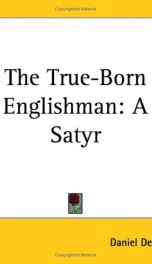
The True-Born Englishman
Series:
Unknown
Year:
Unknown
Raiting:
1/5
A poem by the great 18th-century English novelist, journalist, poet, and government agent, Daniel Defoe, whose literary heritage includes more than 500 books, pamphlets, articles, and poems. This satire was created in defense of William III against the attacks of aristocracy and John Tutchin, and became so popular, that more than 80,000 copies were sold in London streets with lightning speed. It resulted in fines, arrests, imprisonments, and even putting the author in the pillory, where Defoe was saluted by the citizens. “The True-Born Englishman” spoke not only in support of the King, but also defended the achievements of the revolution and the law of the new system. Defoe proves that arrogance and self-interest appear the main traits of the nobility and England has no more old aristocracy. Finally, he contrasts personal valour and services to mendacious family conceit.
Show more
add to favoritesadd In favorites

Tour through the Eastern Counties of England
Series:
Unknown
Year:
Unknown
Raiting:
5/5
Daniel Defoe was a prolific and versatile writer, who wrote more than five hundred books, pamphlets, and journals on various topics (including travel, politics, crime, religion, marriage, psychology and the supernatural).
Show more
add to favoritesadd In favorites
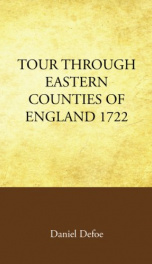
Tour through Eastern Counties of England, 1722
Series:
Unknown
Year:
Unknown
Raiting:
4.5/5
Tour through Eastern Counties of England 1722 is a book written by Daniel Defoe. It is widely considered to be one of the top 100 greatest books of all time. This great novel will surely attract a whole new generation of readers. For many, Tour through Eastern Counties of England 1722 is required reading for various courses and curriculums. And for others who simply enjoy reading timeless pieces of classic literature, this gem by Daniel Defoe is highly recommended. Published by Quill Pen Classics and beautifully produced, Tour through Eastern Counties of England 1722 would make an ideal gift and it should be a part of everyone's personal library.
Show more
add to favoritesadd In favorites
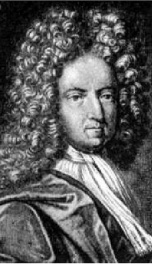
Of Captain Mission
Series:
Unknown
Year:
Unknown
Raiting:
1/5
The Introduction explains : "Defoe has been recognized as the author of 'A General History of the Robberies and Murders of the Most Notorious Pyrates' since 1932 when John Robert Moore suggested that the supposed author, Captain Charles Johnson, like Andrew Moreton, Kara Selym or Captain Roberts, was merely another mask for the creator of 'Robinson Crusoe'. Although most of the first volume is of minor literary importance, the second section which appeared in 1728 as 'The History of the Pyrates' commenced with a life "Of Captain Misson and His Crew," one of Defoe's most remarkable and neglected works of fiction." According to Wikipedia: Daniel Defoe (1659/1661 [?] — 1731), born Daniel Foe, was an English writer, journalist, and pamphleteer, who gained enduring fame for his novel Robinson Crusoe. Defoe is notable for being one of the earliest practitioners of the novel, as he helped to popularise the form in Britain, and is even referred to by some as one of the founders of the English novel. A prolific and versatile writer, he wrote more than five hundred books, pamphlets, and journals on various topics (including politics, crime, religion, marriage, psychology and the supernatural). He was also a pioneer of economic journalism.
Show more
add to favoritesadd In favorites
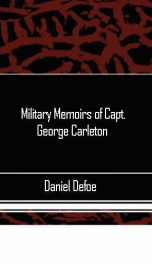
Military Memoirs of Capt. George Carleton
Series:
Unknown
Year:
Unknown
Raiting:
4.5/5
19th century historians have based their work concerning the war in Spain on these memoirs, yet scholars list Military Memoirs of Capt George Carleton as fiction. Daniel Defoe was a fiction writer, journalist and spy. He was one of the first authors to write a novel. Military Memoirs of Capt George Carleton was published in 1728. The book covers the Dutch war in 1672 to the conclusion at the Peace of Utrecht in 1713. Carleton served both on land and at sea under the reigns of King Charles and King James II. The memoirs cover the War in Spain, residences of Carleton, customs and manners of the places Carleton had lived, the monasteries and nunneries in Spain, and Spanish bull-feasts. The question remains is this memoir fiction or fact? It is generally believed that Military Memoirs of Capt George Carleton is in fact just a good adventure tale and nothing more.-----------------------------------------------------------------** Check Out More Great Titles From Penny Books **-----------------------------------------------------------------Simply click on "Penny Books (Editor)" under the title to see a full list of all of our great discounted books!!New titles are being added daily, so be sure to check back often to find more great discounted books!!**Check out PennyBooksPublishing.com to get more information about Penny Books, learn how to follow us on Twitter, and look at all of our great titles!!
Show more
add to favoritesadd In favorites

Memoirs of Major Alexander Ramkins (1718)
Series:
Unknown
Year:
Unknown
Raiting:
3/5
This book was converted from its physical edition to the digital format by a community of volunteers. You may find it for free on the web. Purchase of the Kindle edition includes wireless delivery.
Show more
add to favoritesadd In favorites

The Life and Most Surprising Adventures of Robinson Crusoe, of York, Mariner (1801)
Series:
Unknown
Year:
Unknown
Raiting:
2.5/5
This book was converted from its physical edition to the digital format by a community of volunteers. You may find it for free on the web. Purchase of the Kindle edition includes wireless delivery.
Show more
add to favoritesadd In favorites

The Life and Adventures of Robinson Crusoe of York, Mariner, Volume 1
Series:
Unknown
Year:
Unknown
Raiting:
1/5
This book was converted from its physical edition to the digital format by a community of volunteers. You may find it for free on the web. Purchase of the Kindle edition includes wireless delivery.
Show more
add to favoritesadd In favorites
What readers are saying
What do you think? Write your own comment on this author!
write a commentif you like Defoe Daniel try:
readers also enjoyed
What readers are saying
What do you think? Write your own comment on this author!
write a commentGenre
if you like Defoe Daniel try:
readers also enjoyed
Do you want to read a book that interests you? It’s EASY!
Create an account and send a request for reading to other users on the Webpage of the book!

